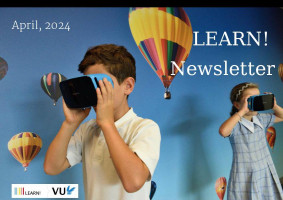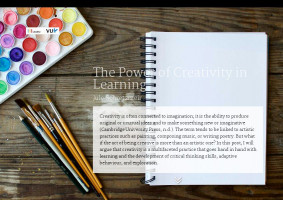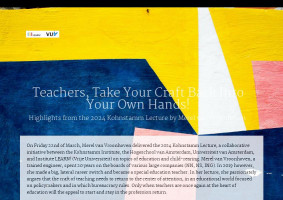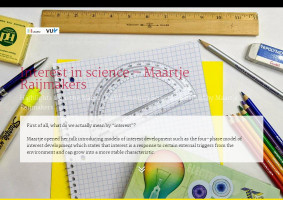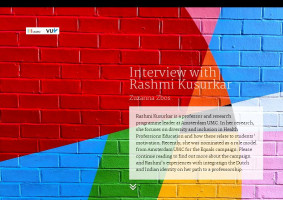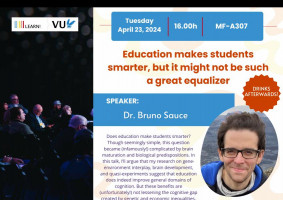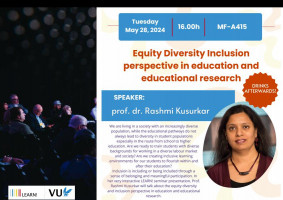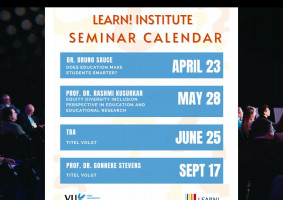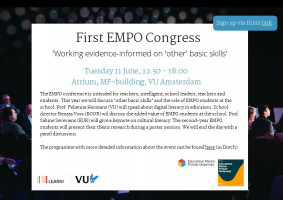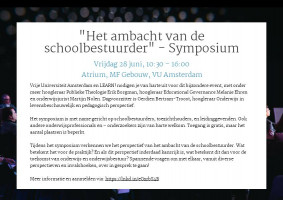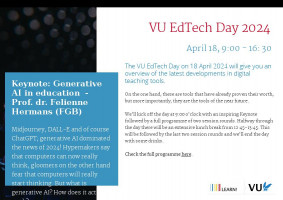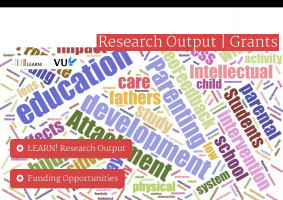Rashmi Kusurkar is a professor and research programme leader at Amsterdam UMC. In her research, she focuses on diversity and inclusion in Health Professions Education and how these relate to students' motivation. Recently, she was nominated as a role model from Amsterdam UMC for the Equals campaign. Please continue reading to find out more about the campaign and Rashmi's experiences with integratign the Dutch and Indian identity on her path to a professorship.
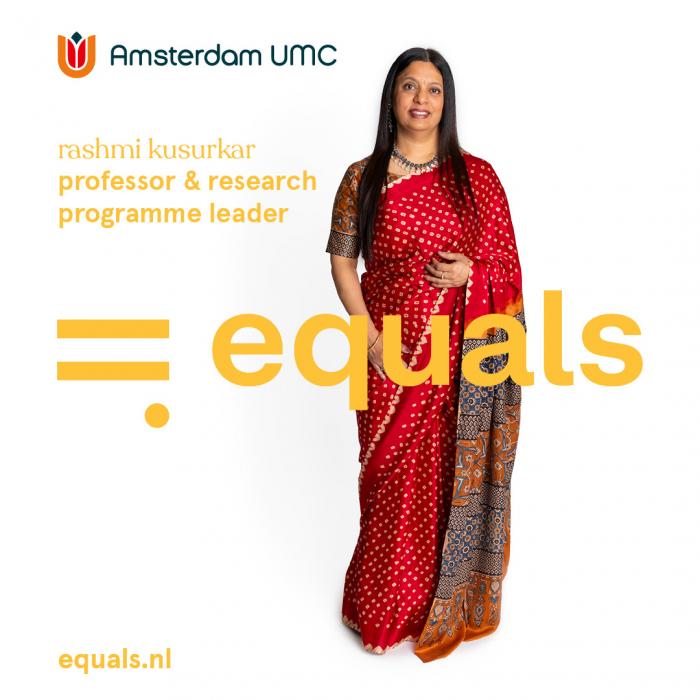
Could you briefly introduce yourself and give an overview of your background and experience?
By background I've been trained as a medical doctor in India, and I completed my specialisation in physiology. I was teaching for about 7 years in Mumbai, India, and then my husband took up a job in Amsterdam. That's how we moved to Amsterdam. I wanted to do a PhD in medical education, but it wasn’t possible to do that in India at that point. When I came to the Netherlands, I had a desire to pursue my dream PhD position, but because I didn’t know anyone in this country, it was really difficult to get started. On top of that, there was hardly any information available in English, all the websites were in Dutch. That is when my husband suggested I should start reaching out to people in real life. I wasn’t proficient at using PubMed, because in India we didn't have those resources back then. In the end I found some papers in which I found potential names I could reach out to, and that’s what I did. I went through 7 to 8 interviews to get the position at the UMC Utrecht. I was very satisfied with it because I got the opportunity to choose my topic and research what I wanted. Drawing onto my former teaching practice in India, I had questions about students' motivation, academic performance and learning. This is what I decided to do for my PhD studies. After 3 years of research, I graduated from UMC Utrecht. At that time, my second supervisor moved to the VU as the director of medical education and invited me to join. I then got a wonderful opportunity to create my own group in education research. I started with two PhD students and then slowly the group expanded. Seven PhD students have graduated from my research programme and currently I am supervising around 12 students, also international.
What is the focus of your research group within Learn?
The name of my group is Developing students for life - Motivation for lifelong learning. Developing students for life means that we try to nurture students to become intrinsically motivated, to constantly learn from the practice and be dedicated to continuing professional development. We focus on students from the moment they start thinking about joining health professions education, which is also our domain, throughout their undergraduate and postgraduate education, as well as during their practice. There are two main research themes within the program: one is about motivation and all the factors that influence motivation, such as gender or background, and at the same time about all the things that motivation influences, like academic performance, professional identity, engagement or even burnout. The other theme focuses on inclusion, equity, diversity and accessibility. Here we look at the basis of people’s background and other factors to see whether people get equitable chances or not in professional development. Through my research group I succeeded in connecting the two themes which have always been connected in my mind. My point of view is that if a person doesn't feel included in the educational or professional environment, they cannot have intrinsic motivation for their work.
The role of inclusion in motivation was also the theme of your inaugural lecture. Could you elaborate more on this topic?
The title of my oration was The ABC of inclusion and motivation, with which I aimed to answer the question of how to bring students to flourish. I use Self-determination theory while talking about motivation. The backbone of that theory is that everyone can flourish with the optimal motivation, meaning that everyone can grow to their potential. But to be able to flourish, you need the desirable type of motivation, namely autonomous motivation; you either have to be genuinely interested in something, or find it important. The other type of motivation is called controlled motivation, and it appears when you are doing something out of internal pressure, for instance because you want to become famous or earn a lot of money, or because someone in the family is pressuring you to do something.
How can you make sure that students and employees are autonomously motivated?
This is exactly why I connect the two themes in my research. Inclusion is an important part of it, because if you don't feel included in your learning or working environment, you can never be autonomously motivated. What the Self-determination theory talks about is 3 basic psychological needs, which are called autonomy, belongingness and competence. This is what the ABC stands for in the title of my oration. According to that theory, for anyone to be autonomously motivated, they need to feel a sense of autonomy or choice in their actions. When a person asks themselves, 'Why do I want to do it?’, the answer should be: ‘because I want to’ and not ‘because someone else wants me to do this’. This is what autonomy is about.
Other important factors are belongingness, which is the need to feel a sense of belonging to peers, to the learning and working environment, and competence. What follows, when people don't feel competent, they will not be autonomously motivated. These are the three basic psychological needs in ABC, but I personally also connect it to inclusion.
"For me, inclusion means the sense of belongingness combined with the empowerment to make meaningful contributions."
So it is possible that someone may feel a sense of belonging, but may not have the power to contribute. That process is called assimilation, where someone from a different culture comes to the majority culture and is accepted only when they exhibit the behaviours of the majority culture. They have a sense of belonging to the group, but their individual characteristics are not valued. This is not inclusion, but rather assimilation.
I always talk about inclusion in the context where you feel a sense of belonging plus the empowerment to contribute meaning. Furthermore, our research shows that if people don’t feel included, it has a negative effect on their motivation, because these three basic ABC needs are not met. People will lose their sense of autonomy, stop feeling competent, and lose the sense of belonging. And because of that, they will no longer be autonomously motivated, but controlled motivated. As we have shown in our previous studies, controlled motivation is more associated with burnout, lower engagement and lower academic performance as compared to autonomous motivation. Thus, in conclusion, what I tried to show is that inclusion is necessary for someone to feel optimally or autonomously motivated, and therefore it is also necessary for our well-being.
Could you give some practical examples of how you can evoke these ABC factors in everyday educational practices?
When you are teaching a group of students, the best you can do is to give them lots of choices. You should be asking questions like: What do you want to study? How do you want to study it? How do you want to assess it? What types of activities do you enjoy doing? There are obviously things which are restricted by the curriculum, like the reading or writing material, but you could always plan a nice activity around it. For example, have a debate in the class with someone speaking for and against a topic, or you could actually ask students how they want to handle a particular topic.
And how does it work on an individual level?
For instance, if there is a very bright student who might want something more than others, I, as a teacher, can address those needs and give the student a more challenging exercise. To give an example, the student can look for an article related to a topic discussed in class and can later explain it to the rest of the students. As a result, there is no additional burden for the rest of the class or the teacher, but the person who wants extra gets extra.
This example concerned the possible adjustments on different levels regarding what to learn or study. However, it can also be about how to learn. Think of a student preparing for a test who wants to effectively revise the information. The student’s task can therefore be to look for real life examples where this can be used and to write it down. The student could also give a presentation about what they have learned so far, followed by a discussion. What is important is that the ideas should come from the students; they are the ones who should decide how they want to learn a certain topic. These are all ways of passing the responsibility to the students, which makes them feel like they have autonomy while the teacher also holds the accountability for facilitating the learning process. So it is possible to give autonomy to students within an already existing structure or curriculum.
The second aspect is competence. Students often receive feedback, however, it is important that the feedback focuses on the activity instead of evaluating them as a good or bad student. Teachers can give such feedback by outlining the aspects that the students did well and pointing out possible areas for improvement. Furthermore, having a one to one relationship with a student or creating activities in the class where they start feeling like a group stimulates that relatedness or belongingness within the group.
The topic of equality and inclusion really shines through in all aspects of your work. Why are these factors so important to your research?
After my PhD, I had meetings with a lot of teachers and people who were working in education. And every time I would start to say something about how things are done in India, people would immediately say something like: but that is in India, that's not relevant for the Dutch context. I find it strange that people say that because students are the same everywhere. Of course there are differences, but there are also overarching similarities. Sadly, few wanted to hear about these similarities. Thus, I was not able to share my knowledge because people could be too close-minded. And whenever I talked about motivation, people would say that in Indian or other collectivistic cultures, students' motivation comes from the parents’ pressure, which is a stereotype. It triggered me and I started wondering why people think like this. And then I started observing things around me and I saw that students who came from collectivistic cultures or people of colour constantly had to face so many barriers and face the same kind of rejection or exclusion everywhere.
This is when I realised the true importance of the topic and decided to write a grant proposal on it. Ironically, my grant proposal wasn’t accepted because they didn't even recognize it as a topic. Nonetheless, I found a possibility to convert it into a PhD project which was taken up by my student Ulviye Işik, who did research on academic motivation and performance of ethnic minority students.In the study we found that the ethnic minority students actually had higher autonomous motivation and that their academic performance did not differ. We were intrigued by the results and wanted to find an explanation. We carried out two qualitative studies where we came to know that students from other backgrounds face everyday discrimination - like people making fun of their names, doubting their abilities and competence in their learning, work and professionalism, giving them poor grades in their clinical performance and judging them as unprofessional in their behaviour. There is a lot of implicit bias, for instance an assumption that their quality of learning is low, which they have to face everywhere. We observed that even though it had a negative effect on their situational (at the moment) motivation, they were so determined and so resilient that they overcame the initial dip in motivation so that the long term motivation to become a doctor was not affected. They went on, they faced all barriers and kept going without giving up, which was amazing to us. And on the basis of that we wrote a consortium grant proposal about the unintended effects of selection on the student population and the applicant pool. We analysed the pipeline from childhood to becoming a medical specialist, and then we expanded it to health professions education, so not just specialists. We found that women with ethnic minority backgrounds have the lowest chances of becoming a medical specialist.
"Overall you could say that I found the topic of motivation, but inclusion found me. It wasn’t my initial intention to do research on inclusion, but I got there because of my experience."
What are the key challenges that you face in promoting inclusion and diversity and education?
The topic of inclusion and diversity is a very uncomfortable one because it is related to the history of slavery and colonisation. I noticed that if you want to make equitable chances for people who are of a different ethnic minority, the majority starts feeling threatened because they think their chances and opportunities will decrease. We faced a lot of challenges when we were presenting our research, in the sense that people were really resistant. At some point I realised that talking about exclusion is not helping me create an impact. And that's when I move towards the story of inclusion. And suddenly there was a change in how people looked at it because everyone wanted to be inclusive. It was surprising how the change of frame and terminology opened doors for our work.
I actually have ethical dilemmas sometimes because I feel like I'm ignoring the people who have exclusion and discrimination experiences while I'm moving forward on inclusion. I feel like I'm not doing justice to them. It's a difficult dilemma to live with because I know I'm doing it for the long term gain since everyone wants to join the movement of inclusion which I'm happy with. But there are times when it really bothers me.
Recently you became a role model from Amsterdam UMC for the Equals campaign. Could you explain what the goals of the campaign are and how you got chosen?
On my way to becoming a professor, I had a lot of experiences about which I talked with the Committee Talent Assessment and the Executive Board to help them understand that it is harder for a person of colour to become a professor. It was sort of expected of me that I would find a sense of belonging in a homogeneous group of white, male professors, but I didn't want to lose my Indian roots. I went through an identity struggle while going through my career path and I chose not to give up my true identity. I actually even have a visual of what it felt like, which is a painting that my sister-in-law made for me. It shows an Indian rose which is at the centre of a painting, which represents my Indian identity, and my Dutch identity is represented by tulips built around it. It was a difficult journey, but I was successful in maintaining my values and still becoming a professor. Then I was invited to join the Steering Committee on Diversity and Inclusion at Amsterdam UMC, meaning that I could finally give input based on my experiences and perspective. When I talk about these things now, people take it more seriously, than when I was an associate professor. Getting the professor position made all the difference in the world, which I knew would happen and that was my main motivation to become one. I was never interested in the title, but in what it could bring further for my group and our research work.
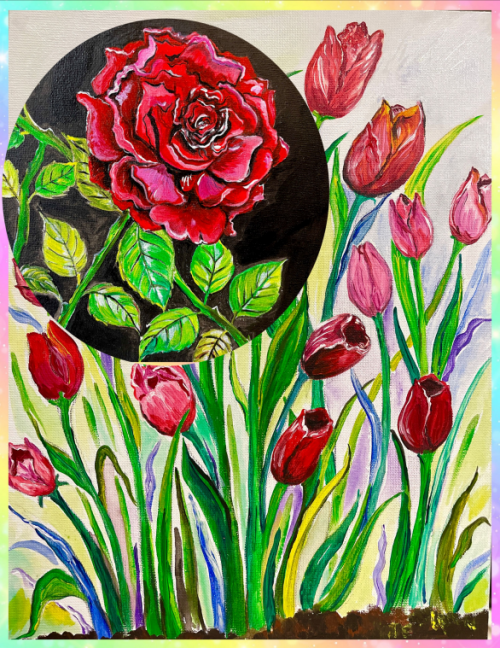
Coming back to the question, Equals is a company that conducts a campaign about equality between men and women, which they have been doing for the last 4 years. Every year, they interview and photograph women from the bigger cities like Amsterdam, Rotterdam and Utrecht, and they advertise it with posters placed all around the city. It is actually the company who has to sign up to become part of the campaign in order to show that they really value equality. It is the first time that Amsterdam UMC participated. I got nominated because of my perspective on diversity and inclusion and became a role model on equality.
After my photoshoot, they asked me to talk about my motivation and why I think that role modelling is important. It connects very well to my research, because we have found that role models are very important particularly to minority students who often don’t see people working in healthcare who look like them. Because of that they think they cannot reach those positions, which is sadly also true. We found that they often don't get into a specialisation because all the supervisors want to pick students who look like them. It has a lot of exponential effects. In our research we have seen that having visible role models is important for students, especially of ethnic minorities, so that they can imagine a future for themselves. So when they asked me to become part of the campaign, I immediately said yes. And then I came to know that there is going to be a poster of me in the centre of Amsterdam, next to the National Opera, which is a very beautiful location. I had never dreamt in my entire life that there would be a poster of me at such a crossroad, especially after all the difficulties I had to go through on my career track to become a professor resulting from the systemic expectations.
What does it mean to you personally to be part of that campaign?
I come from a culture where visibility is not considered important. In my culture, you think that if you work hard and give your best to your work, your work will get recognized eventually. In the Netherlands it is quite the opposite; unless you tell others, ‘I did this’, people don’t think you have done it. That was something I really had to resolve on my way to becoming a professor. In spite of the interesting and innovative research that my research group did, which was being picked up by the media and was also being recognized internationally, I had to work on my visibility within Amsterdam UMC and the VU.
My mentors really helped me in finding and navigating my way through Dutch academia. That's where I learned that having a cup of coffee with people was important, unlike in my culture. It was very different from my own values and initially I couldn't see the point in it because all the effort I was putting into networking was taking away from my research time. Now that I have an integration of these two cultures, I can see the value of doing it, but I do it in my own authentic way. I do it because I believe in building lasting collaborative relationships. I talk about my work and about my team instead of talking about myself. I also don't assume that people would have, for instance, read my article. I think learning this skill of reaching out to people who were not necessarily related to the content of my research was difficult for me.
